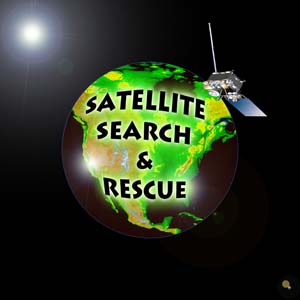| NOAA Magazine || NOAA Home Page |
NOAA
SATELLITES PLAY KEY ROLE IN 222 RESCUES IN 2005;
MORE BEACONS REGISTERED DURING THE YEAR
 Jan.
23, 2006 � NOAA satellites
helped save 222 people throughout the United States and its surrounding
waters from potentially life-threatening emergencies in 2005. NOAA's
polar and geostationary satellites, along with Russia's Cospas spacecraft,
are part of the sophisticated, international Search and Rescue Satellite-Aided
Tracking System, called COSPAS-SARSAT.
(Click NOAA illustration for larger view of NOAA satellite used
to search and rescue mariners and hikers. Click
here for high resolution version. Please credit “NOAA.”)
Jan.
23, 2006 � NOAA satellites
helped save 222 people throughout the United States and its surrounding
waters from potentially life-threatening emergencies in 2005. NOAA's
polar and geostationary satellites, along with Russia's Cospas spacecraft,
are part of the sophisticated, international Search and Rescue Satellite-Aided
Tracking System, called COSPAS-SARSAT.
(Click NOAA illustration for larger view of NOAA satellite used
to search and rescue mariners and hikers. Click
here for high resolution version. Please credit “NOAA.”)
The system uses a constellation of satellites to detect and locate distress signals from emergency beacons onboard aircraft, boats and from hand-held personal locator beacons. Once the satellites pinpoint the location of the distress within the United States or surrounding waters, the information is relayed to the SARSAT Mission Control Center in Suitland, Md., and sent to a Rescue Coordination Center, operated by either the U.S. Air Force (for land rescues), or U.S. Coast Guard (for water rescues.)
"The SARSAT program is doing exactly what it was intended to do—save lives," said retired Navy Vice Adm. Conrad C. Lautenbacher, Ph.D, undersecretary of commerce for oceans and atmosphere and NOAA administrator. "NOAA satellites and the quick responses of the U.S. Air Force and Coast Guard continue to be the difference between life and death."
Since its creation in 1982, COSPAS-SARSAT has been credited with more than 18,500 rescues worldwide, and 5,107 within the United States and its surrounding waters. Most of the rescues each year happen at sea. Alaska led the nation with 65 rescues in 2005, followed by Florida, having 49, with Louisiana, California and Hawaii rounding out the top five with 13, 12 and 10 saves respectively.
Last year also saw a slight rise in the number of people buying and registering emergency beacons with NOAA—19,282 beacons were registered in 2005, compared to 18,343 in 2004. The total number of registered beacons now stands at 142,222.
"The more emergency beacons that are registered with NOAA, the better able SARSAT will perform to save lives," said Gregory W. Withee, assistant administrator of the NOAA Satellite and Information Service.
Other notable SARSAT rescues in 2005:
- On Dec. 31, NOAA satellites detected a distress signal from the fishing boat, 25 miles east of Sarasota. The signal was relayed to the Coast Guard Rescue Coordination Center in Miami, which dispatched a C-130 aircraft that found the stalled boat. The Coast Guard Station Cortez sent a vessel that towed the boat, and the 14-member crew, back into port.
- On Jan. 19, two people were rescued from a life raft after their fishing vessel sank 30 miles east of Atlantic City. NOAA satellites relayed a distress signal to the U.S. Coast Guard, which rescued the pair in time before their raft sank.
- On May 4, five hunters were rescued when their snowmobiles got stuck in a creek near Anaktuvak Pass, Alaska. NOAA satellites picked up a distress signal from a PLB they activated.
- On May 27, NOAA satellites detected a distress signal from an emergency beacon activated by a boater, stranded in the Florida Everglades. A team from the Florida Fish and Wildlife Conservation Commission helped direct other boaters to the area to make the rescue.
- On June 10, U.S. Coast Guard crews—in two separate incidents—rescued five people from choppy waters off the eastern Florida coast. At the time, those rescues pushed the total number of lives saved in the United States, through the SARSAT, passed the 5,000 mark, since the program began in 1982.
Older emergency beacons, which operate on the 121.5 and 243 megahertz frequency, will be phased out by early 2009, when 406 megahertz beacons will be the standard. Emergency beacon owners can register their devices online using the National Beacon Registration Database.
NOAA, an
agency of the U.S. Department of
Commerce, is dedicated to enhancing economic security and national
safety through the prediction and research of weather and climate-related
events and providing environmental stewardship of the nation's coastal
and marine resources.
Through the emerging Global Earth Observation System of Systems (GEOSS),
NOAA is working with its federal partners and nearly 60 countries to
develop a global monitoring network that is as integrated as the planet
it observes.
Relevant Web Sites
NOAA SARSAT Program
NOAA Satellite and Information Service
Media
Contact:
John Leslie, NOAA
Satellite and Information Service, (301) 457-5005